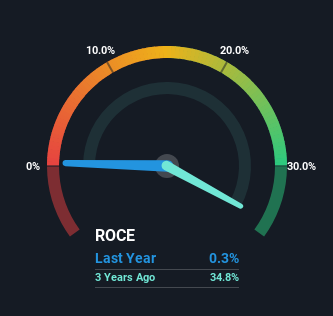The Returns On Capital At Via Renewables (NASDAQ:VIA) Don't Inspire Confidence
If we're looking to avoid a business that is in decline, what are the trends that can warn us ahead of time? A business that's potentially in decline often shows two trends, a return on capital employed (ROCE) that's declining, and a base of capital employed that's also declining. Basically the company is earning less on its investments and it is also reducing its total assets. So after glancing at the trends within Via Renewables (NASDAQ:VIA), we weren't too hopeful.
What Is Return On Capital Employed (ROCE)?
For those who don't know, ROCE is a measure of a company's yearly pre-tax profit (its return), relative to the capital employed in the business. Analysts use this formula to calculate it for Via Renewables:
Return on Capital Employed = Earnings Before Interest and Tax (EBIT) ÷ (Total Assets - Current Liabilities)
0.0028 = US$636k ÷ (US$295m - US$65m) (Based on the trailing twelve months to June 2023).
So, Via Renewables has an ROCE of 0.3%. Ultimately, that's a low return and it under-performs the Electric Utilities industry average of 4.5%.
See our latest analysis for Via Renewables
Historical performance is a great place to start when researching a stock so above you can see the gauge for Via Renewables' ROCE against it's prior returns. If you'd like to look at how Via Renewables has performed in the past in other metrics, you can view this free graph of past earnings, revenue and cash flow.
What Can We Tell From Via Renewables' ROCE Trend?
We are a bit anxious about the trends of ROCE at Via Renewables. The company used to generate 16% on its capital five years ago but it has since fallen noticeably. In addition to that, Via Renewables is now employing 33% less capital than it was five years ago. When you see both ROCE and capital employed diminishing, it can often be a sign of a mature and shrinking business that might be in structural decline. If these underlying trends continue, we wouldn't be too optimistic going forward.
What We Can Learn From Via Renewables' ROCE
In summary, it's unfortunate that Via Renewables is shrinking its capital base and also generating lower returns. We expect this has contributed to the stock plummeting 75% during the last five years. That being the case, unless the underlying trends revert to a more positive trajectory, we'd consider looking elsewhere.
One final note, you should learn about the 4 warning signs we've spotted with Via Renewables (including 2 which are a bit concerning) .
If you want to search for solid companies with great earnings, check out this free list of companies with good balance sheets and impressive returns on equity.
Have feedback on this article? Concerned about the content? Get in touch with us directly. Alternatively, email editorial-team (at) simplywallst.com.
This article by Simply Wall St is general in nature. We provide commentary based on historical data and analyst forecasts only using an unbiased methodology and our articles are not intended to be financial advice. It does not constitute a recommendation to buy or sell any stock, and does not take account of your objectives, or your financial situation. We aim to bring you long-term focused analysis driven by fundamental data. Note that our analysis may not factor in the latest price-sensitive company announcements or qualitative material. Simply Wall St has no position in any stocks mentioned.

